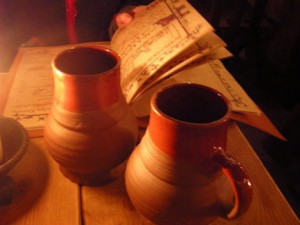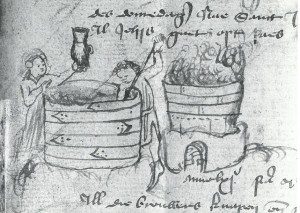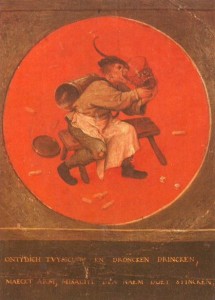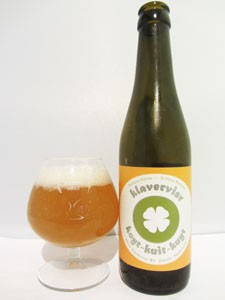Gruit & Kuit
 To be perfectly honest, I started this quest for the lost beers of Holland mainly looking for recipes of the 18th and 19th century. Why? Two reasons: they are easier to find and to interpret, and nobody had really written about them before. So far, every new beer recipe feels like a lost treasure found after deep digging. Still, the 19th century is not exactly the heyday of Dutch beer. The Middle Ages were. For a few centuries Holland was the leading beer exporting country that taught even the British and Belgians how to brew beer with hops. But we’ll get to that.
To be perfectly honest, I started this quest for the lost beers of Holland mainly looking for recipes of the 18th and 19th century. Why? Two reasons: they are easier to find and to interpret, and nobody had really written about them before. So far, every new beer recipe feels like a lost treasure found after deep digging. Still, the 19th century is not exactly the heyday of Dutch beer. The Middle Ages were. For a few centuries Holland was the leading beer exporting country that taught even the British and Belgians how to brew beer with hops. But we’ll get to that.
The Middle Ages, then. Forget the perpetually repeated tale that this was such a dark, gloomy, wet and muddy era: in the 13th century, at the start of this story, the climate in Europe was actually a few degrees warmer than it is now. And that without a greenhouse effect. The beer though, was not the drink we are used to now. Everybody drank it, mainly because there was nothing else: milk was for children and old people, and water was sometimes dirty but mostly boring. Beer was the drink of choice. However, it was then mainly made out of oats, with a bit of wheat thrown in from time to time. No barley. And no hops either: the beer was flavoured with herbs. Or, in proper mediaeval Dutch: gruit. (Read more: Fact check: where did gruit occur?)
 One thing was not different from our days: the government liked to tax. The easiest way to levy a tax on beer was to ensure a government monopoly on gruit and then sell the stuff at the highest price possible. The local duke or count would appoint a person to produce and sell the gruit, a man called, perhaps inevitably, a ‘gruiter’. And what was in this gruit mix? Luckily, some old documents tell us about what purchases such a gruiter would make. In the town of Zwolle his shopping list contained ‘gale, heavy herb and resin’, the heavy herb probably being laurel or blueweed. The gruiter would then grind it and sell it for good money, after all, there was no competition.[1] (Read more on the ingredients of gruit: Gruit: nothing mysterious about it)
One thing was not different from our days: the government liked to tax. The easiest way to levy a tax on beer was to ensure a government monopoly on gruit and then sell the stuff at the highest price possible. The local duke or count would appoint a person to produce and sell the gruit, a man called, perhaps inevitably, a ‘gruiter’. And what was in this gruit mix? Luckily, some old documents tell us about what purchases such a gruiter would make. In the town of Zwolle his shopping list contained ‘gale, heavy herb and resin’, the heavy herb probably being laurel or blueweed. The gruiter would then grind it and sell it for good money, after all, there was no competition.[1] (Read more on the ingredients of gruit: Gruit: nothing mysterious about it)
Times changed. The 14th brought the Black Death and a worsening climate, but also hops. Around the year 1300 brewers in Hamburg, Germany started using it, and some twenty years later the Dutch followed suit as the North Sea coast already had a busy trading network. In Dutch cities they would brew ‘hoppenbier’: a heavy beer consisting mainly of oats and a quarter or a third of wheat. Dutch historian Leen Alberts has calculated that it must have contained 6 to 8 % of alcohol.[2]
Hop had a few advantages that gruit had not. The beer was easier to keep, it got a fresher taste (bitter instead of spicy) and, not unimportantly: it helped you avoid buying gruit at the gruiter’s. In 1404, when the bishop of Utrecht leased the right to levy gruit tax to the town of Zwolle, he complained about the ‘hop beer, that people commonly drink in our land, which has very much diminished and destroyed our gruit’.[3] And so, of course, it wasn’t before long that a tax on hops was created.
In the year 1374, Hamburg made some important changes in the brewing process. They started brewing ‘white beer’ instead of ‘red beer’. The most important innovation was, oddly, the use of barley: some 90% of it, and 10% wheat. This Hamburg white beer quickly became popular and it wasn’t before long or the Dutch started making a similar beer. In Holland it was known as ‘kuit’ or ‘koyt’ and with only 4 to 6% ABV it was a lot less heavy than the already existing hoppenbier. There’s no clue by the way where the word ‘kuit’ may come from; maybe from the French ‘cuit’ which means ‘cooked’. In any case, it was hopped.[4]
 The Dutch were trend setters with their hopped beer. They exported to Brabant and Flanders, regions that are now in Belgium. Over there, brewers were still using gruit and their tart, unkeepable ale was no match for the hoppenbier and kuit from Dutch towns like Gouda, Delft and Haarlem. Already by 1400, brewers at Lier near Antwerp were trying to brew beers ‘na de wijse van Haerlam’, or ‘in the Haarlem way’. I suppose you could argue that it was the Dutch who taught Belgium how to brew beer…[5]
The Dutch were trend setters with their hopped beer. They exported to Brabant and Flanders, regions that are now in Belgium. Over there, brewers were still using gruit and their tart, unkeepable ale was no match for the hoppenbier and kuit from Dutch towns like Gouda, Delft and Haarlem. Already by 1400, brewers at Lier near Antwerp were trying to brew beers ‘na de wijse van Haerlam’, or ‘in the Haarlem way’. I suppose you could argue that it was the Dutch who taught Belgium how to brew beer…[5]
In France, the old word ‘cervoise’ for ‘unhopped ale’ was completely replaced by the word ‘bière’, which of course came from the Dutch ‘bier’. From Holland, beers were exported to the Rhineland and Westphalia, in what is now Germany. And Dutch beer reached England. England, until then, only knew ale: an unhopped drink, which probably did not contain any herbs either. Just like all their neighbouring countries, the English fell for the the hopped malt liquor, and they thought it so different from their ale, that they designated it with a completely new word, borrowed from Dutch: beer.
In the fifteenth and sixteenth centuries, a lot of Flemish, Dutch and German brewers migrated to England to set up breweries there. For the next 200 years they would have a big impact on English brewing, so that by the beginning of the 17th century Dutch and Germans were owning at least half of the greater breweries in London. Interestingly, as a result ale and beer remained to very distuinguished drinks, both labeled ‘malt liquor’ but made by different people belonging to different guilds: the ale brewers and the beer brewers. Ale became a hopped drink, but always less hopped than beer. It was only when pale ale and especially India Pale Ale appeared, the latter at the beginning of the 19th century, that the hopped/non-hopped divide between ale and beer was blurred. But that’s another story.
Meanwhile, back in Holland, kuit had run its course. Gruitbier had made way for hoppenbier, hoppenbier was first made seasonal and then completely replaced by kuit and by the seventeenth century it was kuit itself that had gained a bad reputation. Around 1600 the kuit of the city of Delft was described thus: ‘For the common people also a small beer is brewed, called Keuyte of Delft, for which the water has only run through the spent grain.’  As a luxury beer, kuit was replaced by beers called Pharao, Israel and ‘English’.[6]
As a luxury beer, kuit was replaced by beers called Pharao, Israel and ‘English’.[6]
So what did this kuit, that taught the English to use hops, taste like? Fortunately, a few Dutch beer history lovers have devised a recipe for this long lost megaseller. What’s more, they also invited Dutch craft brewers to brew it again. Kuit is back, thanks to the people of the Campaign Dutch Beer Styles! You’d care more for a hoppenbier, you say? The Haarlem-based brewery Jopen has been brewing a recreated version of it since 1994. Also, they have a Koyt, based on a historical kuit grist but flavoured with spices, so it actually is a kuit-gruit crossover.[7] Medieval beer crossovers? Only in Holland.[8]
Kuit[9]
Dutch-Style Kuits (Kuyt, Koyt) are gold to copper colored ale. Chill haze and other haze is allowable. The overall aroma character of this beer is grain emphasized with a grainy-bready accent. Hop aroma is very low to low from noble hops or other traditional European varieties. The distinctive character comes from use of minimum 45% oat malt, minimum 20% wheat malt and the remainder pale malt. Hop flavor is similar to aroma very low to low from noble or other traditional European varieties. Hop bitterness is medium-low to medium in perceived intensity. Esters may be present at low levels. Very low levels of diacetyl are acceptable. Acidity and sweet corn-like DMS (dimethylsulfide) should not be perceived. This style of beer was popular in the Netherlands from 1400-1550. Body is low to medium.
• Original Gravity (°Plato) 1.050 – 1.080 (12.4 – 19.3)
• Apparent Extract/Final Gravity (°Plato) 1.006 – 1.015 (1.5 – 3.7)
• Alcohol by Weight (Volume) 3.80% – 6.30% (4.70% – 7.90%)
• Bitterness (IBU) (25 – 35)
• Color SRM (EBC) 5 – 12.5 (10 – 25)
[1] R. E Kistemaker and V.T. van Vilsteren (ed.), Beer! The story of Holland’s favourite drink, Amsterdam 1994, p. 21-22.
[2] Leen Alberts, ‘Bier drinken met maten’, in: Jaarboek voor middeleeuwse geschiedenis, part 13 (2010), Hilversum 2010, p. 113-166.
[3] Kistemaker and Van Vilsteren, Beer, p. 20-21.
[4] Alberts ‘Bier drinken met maten’, p. 137, 141.
[5] Erik Aerts, Het bier van Lier. De economische ontwikkeling van de bierindustrie in een middelgrote Brabantse stad (einde 14de-begin 19de eeuw), Brussels 1996, p. 151.
[6] Quoted in: Reinier Boitet, Beschryving der stadt Delft, Delft 1729, p. 645.
[7] Back in 1994, when Jopen created this beer, the historical kuit was believed to have been a gruit ale. More recently, it has turned out that is was a hopped beer. It seems Jopen is now slowly phasing out the ‘koyt’ name or at least they feature the name ‘gruitbier’ more prominently.
[8] This article was based on an earlier version in Dutch, http://verlorenbieren.nl/verloren-bieren-21-gruit-koyt-en-kuit/.
[9] https://www.brewersassociation.org/wp-content/uploads/2015/03/2015-brewers-association-beer-style-guidelines.pdf Note that they call it an ale, by which they probably mean a top-fermented beer. Historically speaking, kuit is definitely NOT an ale: in the 1400s, ‘ale’ was the English term describing an unhopped malt liquor, while kuit was hopped.





